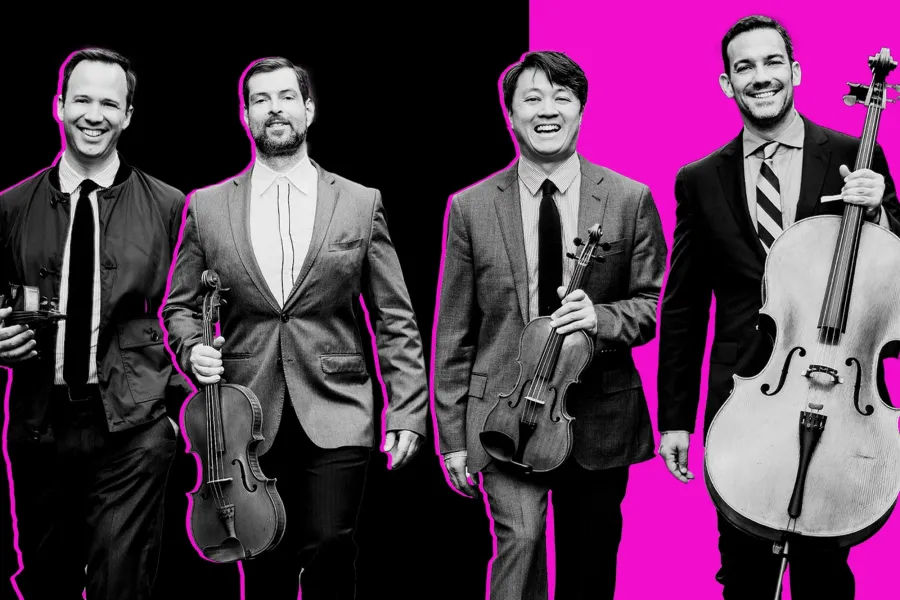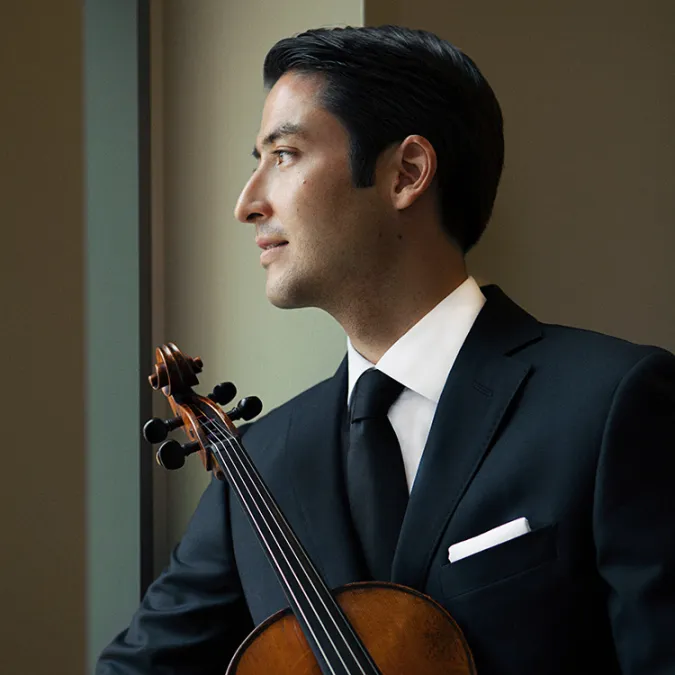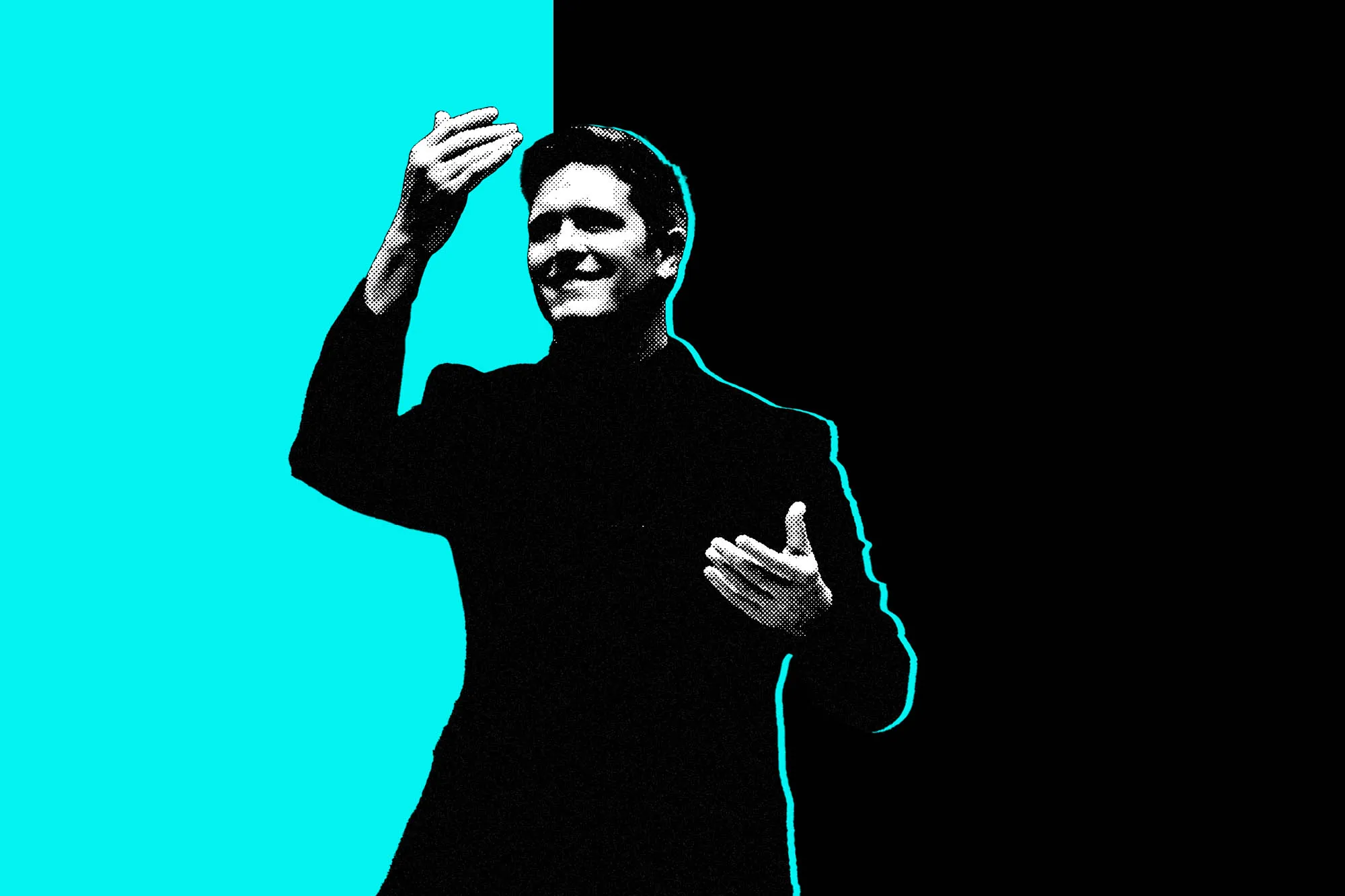
Daniel Ching, violin
William Fedkenheuer, violin
John Largess, viola
Joshua Gindele, cello
Masumi Per Rostad, viola
This concert will last about 80 minutes with oneintermission.
Please silence your electronic devices.
Photography, video, or recording of any part of this performance is prohibited
Program
Johannes Brahms
String Quintet No. 1 in F Major, Op. 88
Allegro non troppo ma con brio
Grave ed appassionato – Allegretto vivace – Presto
Allegro energico – Presto
intermission
String Quintet No. 2 in G Major, Op. 111
Allegro non troppo, ma con brio
Adagio
Un poco allegretto
Vivace, ma non troppo presto
About the Program
Program notes by Mark Bilyeu
Johannes Brahms
String Quintet No. 1 in F Major , op. 88
Born May 7, 1833, Hamburg, Germany
Died April 3, 1897, Vienna, Austria
Composed 1882
Premiered December 29, 1882, Frankfurt, Germany
Duration 30 minutes
String Quintet No. 2 in G Major, op. 111
Composed 1890
Premiered October 22, 1882, Hamburg, Germany
Duration 30 minutes
In 1869, a thirty-something Johannes Brahms decided to make Vienna his home. After travels across much of Europe, he valued the bustling energy of a city who put arts and culture to the fore; rather than, say, Munich, which, according to Brahms, only cared about food and beer. The urban setting was not always good for Brahms’ productivity as a composer, however, and he would often spend his summers in the more serene, rural settings to focus on his writing. One such place was Bad Ischl, in the Salzkammergut in Upper Austria, which was the birthplace of his two string quintets. Brahms had a special affection for the viola, calling it the “instrument of the heart,” and so, like Mozart, chose to add an additional viola to the standard quartet formation when crafting his quintets (which differs from Schubert’s multi-cello quintets).
Written in 1890, Brahms’ String Quintet No. 2 in G Major was intended to be his last work. When sending a final proof to his editor, he enclosed a letter that said "With this letter you can bid farewell to my music, because it is certainly time to leave off..." The work was originally sketched to be for larger forces, and we hear that in the lush, shimmer, and vibrant opening bars of the first movement. The second movement, Andante, is marked by its serene beauty, featuring a poignant theme introduced by the viola that we cannot help but understand to be Brahms’ own schwanengesang (swan song). The Scherzo brings a sense of joy and optimism, while the final movement concludes the quartet with a sense of reflection and grace. The work has been dubbed the “Prater Quintet,” after the 4 mile-long park in Vienna which housed coffee shops, beer gardens, and restaurants, and of which Brahms was a fixture. According to his first biographer, Max Kalbach, after hearing the first few notes of the second quintet, Kalbach exclaimed: ‘Brahms in the Prater!’ to which Brahms replied: ‘You’ve got it!”’
Brahms’ first quintet came eight years earlier. Composed in 1882 at the age of 49, came hot on the heels of his first string quartet, showing a new confidence in his own ability to write for strings. "You have never before had such a beautiful work from me” he wrote to his publisher. The work unfolds with a lyrical first movement that introduces lush melodies, followed by a lively scherzo that embodies playful energy. The poignant slow movement reveals Brahms’s gift for lyrical writing, with one reviewer calling it “a veritable gem of melodic beauty,” while the finale brings the quintet to a vibrant conclusion with fugal writing that would have made Beethoven jealous. Brahms was unusually confident about this work, writing in a letter to friend and confidant Clara Schumann, he called the work “one of my finest."
Both works remain staples of the chamber music repertoire, showcasing Brahms’ life-long ability to showcase the emotional depth of Romanticism within the Classical structures he had inherited. The opportunity to hear them both in a single concert is a gift.
About the Artists
Masumi Per Rostad

Praised for his “burnished sound” (The New York Times) and described as an “electrifying, poetic, and sensitive musician,” the Grammy Award-winning, Japanese-Norwegian violist Masumi Per Rostad hails from the gritty East Village of 1980s New York. He was raised in an artist loft converted from a garage with a 1957 Chevy Belair as the remnant centerpiece in their living room. Masumi began his studies at the nearby Third Street Music School Settlement at age three and has gone on to become one of the most in demand soloists, chamber musicians, teachers. In addition to maintaining an active performance schedule, he serves on the faculty of the prestigious Eastman School of Music in Rochester, NY.
Masumi regularly tours internationally and has performed at many of the most prominent festivals, including Marlboro, Spoleto USA, Music@Menlo, Caramoor, Music in the Vineyards, Bowdoin, and the Aspen Music Festival. His guest violist collaborations include programs with the St Lawrence, Ying, Pavel Haas, Miró, Verona, and Emerson String Quartets, as well as with the Horszowski Trio. He toured and recorded extensively as a former member of the International Sejong Soloists. He can be heard on the Cedille Records, Naxos, Hyperion, Musical Observations, Bridge, and Tzadik record labels.
As a member of the Pacifica Quartet for almost two decades (2001-2017), Masumi regularly performed in the world’s greatest halls including Amsterdam’s Concertgebouw, Tokyo’s Suntory Hall, Sydney’s City Hall, New York’s Carnegie Hall and Lincoln Center, London’s Wigmore Hall, Vienna’s Konzerthaus and Musikverein, Munich’s Herkuleshaal, Paris’ Louvre and Cité de la Musique, and Berlin’s Konzerthaus among many others. He was full professor of viola and chamber music as quartet-in-residence at Indiana University's Jacobs School of Music. In 2006, the ensemble was awarded the coveted Cleveland Quartet Award, Avery Fisher Career Grant, and they were also named Musical America’s 2009 Ensemble of the Year.
Masumi is an ardent advocate for the arts, and often sought after as a contributing writer to such publications as the Huffington Post, Strings and Gramophone magazines as well as The Guardian.
Passionate about breaking down barriers that prevent people from enjoying Classical music, Masumi was the founder of DoCha, a chamber music festival in Champaign, Illinois that produced innovative events with a focus on engaging new audiences through fun and inventive programming. DoCha-hosted events featured unique collaborations between members of the University and multi-genre presentations from Classical chamber music to contemporary dance, the spoken word, and much more. All programs were free of charge and took place at a beautiful former community Opera House. Other activities of DoCha, included ‘in-reach’ performances for elementary school students as well as master classes, competitions and performance opportunities for local music students.
Masumi has served on the faculties of the University of Illinois at Urbana-Champaign, Jacobs School of Music at Indiana University, The University of Chicago, Longy School of Music, and Northwestern University. He has given master classes at The Colburn School, Cleveland Institute of Music, The Aspen Music Festival, Bowdoin International Music Festival, Interlochen and San Francisco Conservatory among many others.
He received his bachelor and master of music degrees from The Juilliard School. There, he studied with legendary violist and pedagogue Karen Tuttle from the age of 17 and was made her teaching assistant just three years later at the age of 20. At Juilliard, he was awarded the ‘Lillian Fuchs Award’ for the most outstanding graduating violist. He also won the Juilliard School Concerto Competition and performed the world premiere of Michael White's Viola Concerto in Lincoln Center’s Avery Fisher Hall, with conductor James DePreist. That same year he gave the New York premiere of Paul Schoenfield's Viola Concerto with the Juilliard Symphony to critical acclaim. In 2008 he was awarded the ‘Rising Star Award’ by the Third Street Music School Settlement for his musical achievements
Masumi lives in Rochester, NY with his wife Sonia—a concert pianist—and their daughter, Ling. He is professor of viola and chamber music at the Eastman School of Music. He is a D’Addario Artist and has used their strings since 1999. Celebrating a 400 year birthday in 2019, his Amati viola was crafted in Cremona, Italy in 1619.
Miró Quartet

The Miró Quartet is one of America’s most celebrated and dedicated string quartets, having been labeled by The New Yorker as “furiously committed” and noted by the Cleveland Plain Dealer for its “exceptional tonal focus and interpretive intensity.” For over twenty-five years the Quartet has performed throughout the world on the most prestigious concert stages, earning accolades from critics and audiences alike. Based in Austin, TX, and thriving on the area’s storied music scene, the Miró takes pride in finding new ways to communicate with audiences of all backgrounds while cultivating the longstanding tradition of chamber music.
In their 2023-24 season, the Miró Quartet embarks on a new performance and recording project with pianist Lara Downes. Here on Earth features musical depictions of planet earth, its evolution, and the lives of its inhabitants, with works spanning a century of cultural shift that begins with Darius Milhaud’s La Création du Monde, performed in a new arrangement for piano and string quartet. Upcoming performances include the premiere of a new version of Kevin Puts’ Credo with the Naples Philharmonic, as well as performances for the Chamber Music Society of Lincoln Center, the Mondavi Center for the Performing Arts, the Saratoga Perfoming Arts Center, and Premiere Performances in Hong Kong.
Miró Quartet took its name and its inspiration from the Spanish artist Joan Miró, whose Surrealist works — with subject matter drawn from the realm of memory, dreams, and imaginative fantasy — are some of the most groundbreaking, influential, and admired of the 20th century.
Upcoming Events

Our annual holiday concert returns this year, but expanded!
Our Combined Choirs and Wind Ensemble will anchor the program, but this year they will be joined by other Butler School ensembles and soloists; a collage of sounds for the holiday season!
Saturday, December 7, 7:30 p.m.
Sunday ,December 8, 4:00 p.m.
Bates Recital Hall
Yamazalde Trio
Thursday, October 31, 7:30 p.m.
Bates Recital Hall
John Largess, viola & Tamar Sanikidze, piano
Clara & Johannes
Thursday, November 7, 7:30p.m.
Bates Recital Hall
University Orchestra
Tuesday, November 19, 7:30 p.m.
Bates Recital Hall
Symphony Orchestra
Monday, December 9, 7:30 p.m.
Bates Recital Hall
Miró Quartet
Friday, January 24, 7:30 p.m.
Bates Recital Hall
Symphony Orchestra
Featuring Ebonee Thomas, flute
Friday, February 7, 7:30 p.m.
Bates Recital Hall
Event Details
$10–20
All University of Texas at Austin students are allowed one free ticket as long as they are available. Student tickets must be picked up at the Box Office with valid student I.D. Seating is unassigned.
If you are a patron with ADA needs, please email tickets@mail.music.utexas.edu and we will reserve ADA seating for you.

